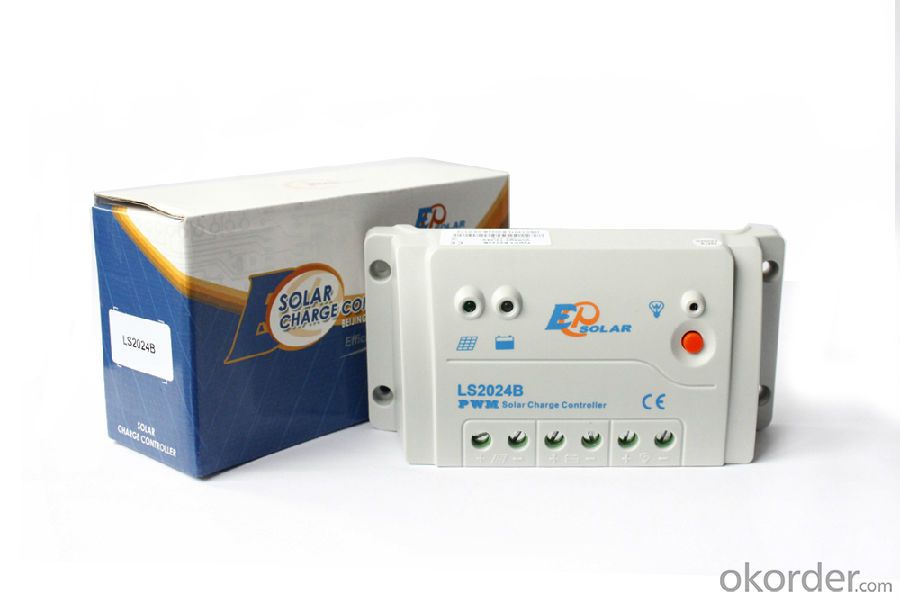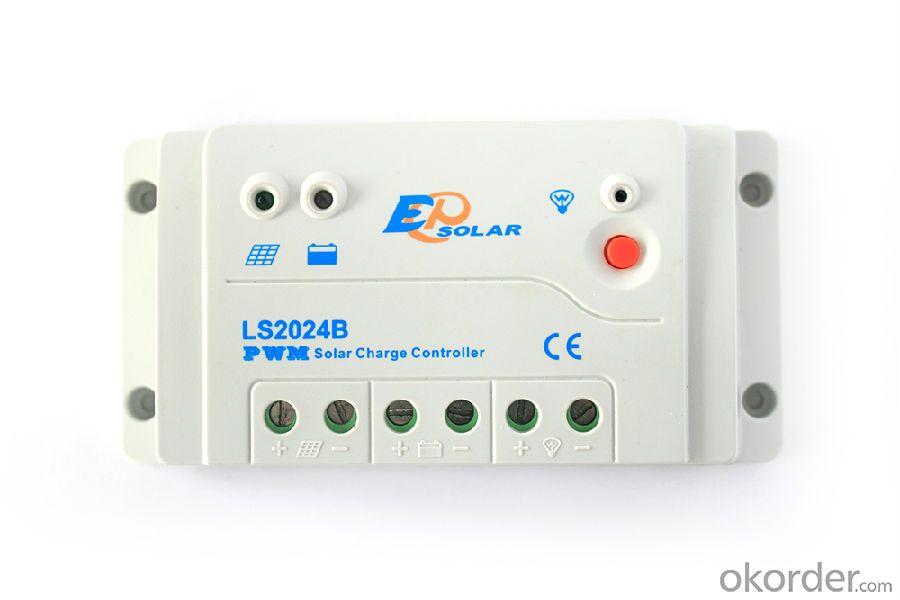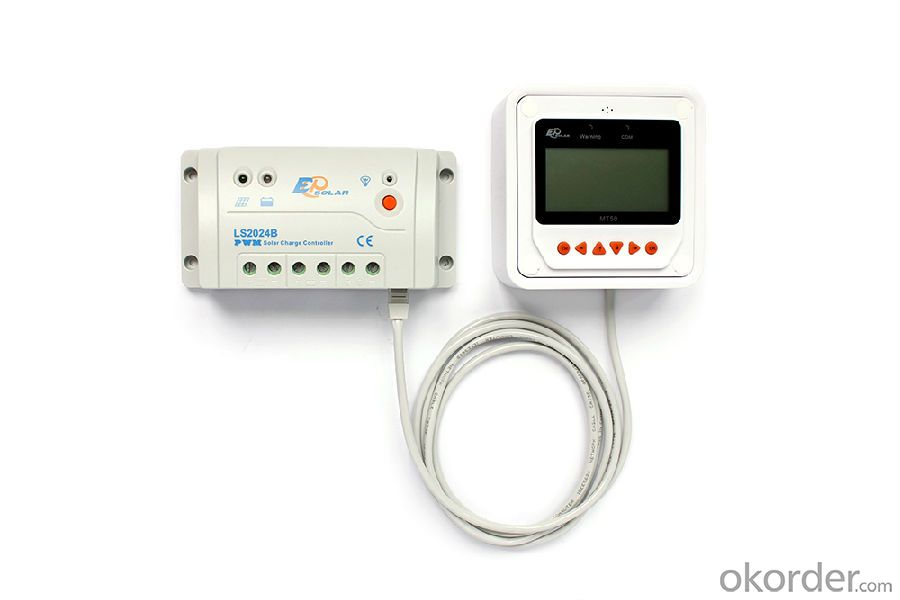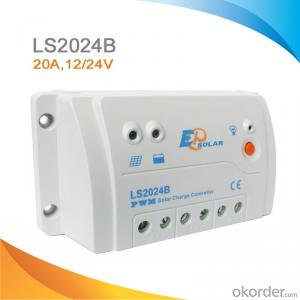PWM Solar Charge Controller,20A 12/24V,LS2024B
OKorder Service Pledge
OKorder Financial Service
You Might Also Like
Descriptions:
A charge controller, or charge regulator is basically a voltage and/or current regulator to keep batteries from overcharging. It regulates the voltage and current coming from the solar panels going to the battery. Most "12 volt" panels put out about 16 to 20 volts, so if there is no regulation the batteries will be damaged from overcharging. Most batteries need around 14 to 14.5 volts to get fully charged.
Features:
·High efficiency PWM charging with temperature compensation
·3 LEDs shows PV charging, battery and load status
·External temperature sensor interface
·RS-485 bus communication
·Open standard Modbus communication protocol
·Software update function
·Diversified load control modes : Manual, Light ON/OFF, Light ON+ Timer, Time Control
·Battery type selection: Gel, sealed, flooded and User type
·Real-time monitor
·Programmable parameters
·LVD or SOC load disconnect function
·Energy statistics function
Electronic Protections:
·PV short circuit
·PV reverse polarity
·Battery overcharge
·Battery over discharge
·Battery reverse polarity
·Load short circuit
·Load overload
·Overheating
Specification:
Electrical parameters | LS1024B | LS2024B | LS3024B |
Nominal System Voltage | 12 / 24V auto work | ||
Rated Battery Current | 10A | 20A | 30A |
Maximum battery voltage | 50V | ||
Grounding | Common positive | ||
Self-consumption | 8.4mA(12V),7.8mA(24V) | ||
Temp. compensation | -3mV/℃/2V(25℃ ref) | ||
Equalize charging voltage | Sealed: 14.6V, Flooded: 14.8V, User-defined: 9~17V | ||
Boost charging voltage | Gel: 14.2V, Sealed: 14.4V, Flooded: 14.6V, User-defined: 9~17V | ||
Float charging voltage | Gel /Sealed /Flooded: 13.8V, User-defined: 9~17V | ||
Low voltage reconnect voltage | Gel /Sealed /Flooded: 12.6V, User-defined: 9~17V | ||
Low voltage disconnect voltage | Gel /Sealed /Flooded: 11.1V, User-defined: 9~17V | ||
Working temp. | -35℃~+55℃ | ||
Humidity | ≤95% (NC) | ||
Enclosure | IP30 | ||
Dimension | 138.6x69.3x37mm | 159.6x81.4x47.8mm | 200.6x101.3x57mm |
Terminal | 4mm2 | 10mm2 | 10mm2 |
Net weight | 0.13kg | 0.3kg | 0.5kg |



- Q:Can a solar controller be used with a solar generator?
- Yes, a solar controller can be used with a solar generator.
- Q:Can a solar controller handle high voltage fluctuations?
- No, a solar controller is not designed to handle high voltage fluctuations. It is designed to regulate and control the voltage output from solar panels to ensure a stable and safe charging process for batteries or other devices. High voltage fluctuations can potentially damage the controller and compromise its functionality.
- Q:Are there any safety features built into solar controllers?
- Yes, solar controllers typically have safety features built-in to protect the system and users. Some common safety features include overcharge protection, short circuit protection, reverse polarity protection, and temperature compensation. These features help prevent damage to the batteries and ensure the safe operation of the solar system.
- Q:How does a solar controller prevent excessive heating of batteries?
- A solar controller prevents excessive heating of batteries by regulating the amount of charge flowing into them from the solar panels. It monitors the battery's voltage and temperature, adjusting the charging rate accordingly to prevent overcharging and overheating. Additionally, some advanced solar controllers have built-in temperature sensors that can automatically adjust the charging parameters based on the battery's temperature, ensuring optimal charging without risking damage or excessive heat buildup.
- Q:What is the role of a battery temperature sensor in a solar controller?
- The role of a battery temperature sensor in a solar controller is to monitor and regulate the temperature of the battery. This sensor ensures that the battery operates within its optimal temperature range, which helps to prolong its lifespan and improve its performance. Additionally, it helps prevent overheating or freezing conditions that could potentially damage the battery.
- Q:Can a solar controller be used in a portable solar system?
- Yes, a solar controller can be used in a portable solar system. A solar controller is responsible for regulating the flow of electricity from the solar panels to the batteries, preventing overcharging and damage. In a portable solar system, where batteries are often used to store the energy generated by the panels, a solar controller is essential to ensure efficient and safe charging.
- Q:Do solar controllers have built-in battery temperature compensation?
- Yes, solar controllers typically have built-in battery temperature compensation. This feature allows the controller to adjust the charging voltage based on the temperature of the battery, ensuring optimal charging and extending the battery's lifespan.
- Q:Can a solar controller be used with a solar-powered outdoor entertainment system?
- Yes, a solar controller can be used with a solar-powered outdoor entertainment system. A solar controller regulates and optimizes the charging process of the solar panels, ensuring that the energy generated is efficiently stored in the batteries of the system. This helps to prevent overcharging and extend the lifespan of the batteries. Therefore, using a solar controller is highly recommended for any solar-powered outdoor entertainment system to enhance its performance and reliability.
- Q:Can a solar controller be used with a solar pool heater?
- Yes, a solar controller can be used with a solar pool heater. A solar controller helps regulate and optimize the performance of the solar panels by monitoring the temperature and flow rate of the pool water. It ensures that the pool heater operates efficiently and effectively.
- Q:How does a solar controller handle shading or partial obstruction of solar panels?
- A solar controller handles shading or partial obstruction of solar panels by employing Maximum Power Point Tracking (MPPT) technology. This technology constantly monitors the voltage and current output of the solar panels and adjusts the operating conditions to optimize power generation. When shading occurs, the solar controller identifies the affected panels and dynamically adjusts the electrical connection to bypass the shaded area, ensuring that the unshaded panels continue operating at their maximum efficiency. This way, the solar controller minimizes the impact of shading or partial obstruction on the overall performance of the solar panels.
1. Manufacturer Overview |
|
|---|---|
| Location | |
| Year Established | |
| Annual Output Value | |
| Main Markets | |
| Company Certifications | |
2. Manufacturer Certificates |
|
|---|---|
| a) Certification Name | |
| Range | |
| Reference | |
| Validity Period | |
3. Manufacturer Capability |
|
|---|---|
| a)Trade Capacity | |
| Nearest Port | |
| Export Percentage | |
| No.of Employees in Trade Department | |
| Language Spoken: | |
| b)Factory Information | |
| Factory Size: | |
| No. of Production Lines | |
| Contract Manufacturing | |
| Product Price Range | |
Send your message to us
PWM Solar Charge Controller,20A 12/24V,LS2024B
OKorder Service Pledge
OKorder Financial Service
Similar products
New products
Hot products
Hot Searches
Related keywords






























